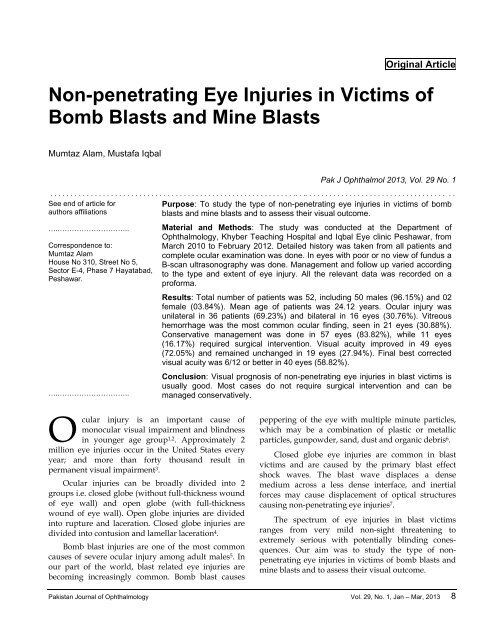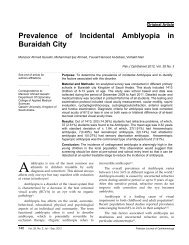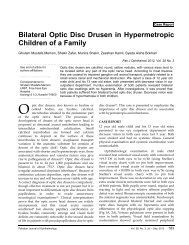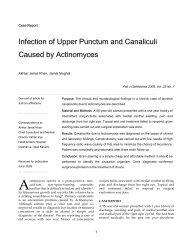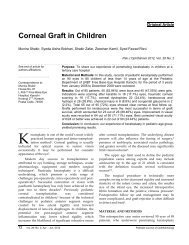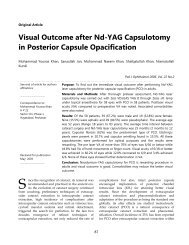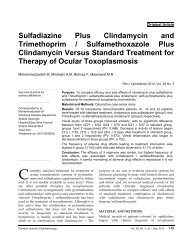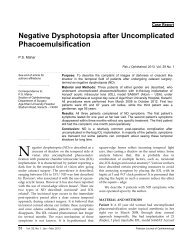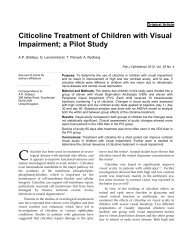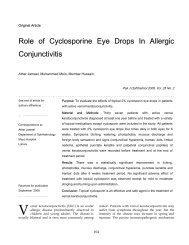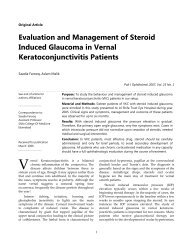Non-penetrating Eye Injuries in Victims of Bomb Blasts and Mine ...
Non-penetrating Eye Injuries in Victims of Bomb Blasts and Mine ...
Non-penetrating Eye Injuries in Victims of Bomb Blasts and Mine ...
- No tags were found...
Create successful ePaper yourself
Turn your PDF publications into a flip-book with our unique Google optimized e-Paper software.
Orig<strong>in</strong>al Article<strong>Non</strong>-<strong>penetrat<strong>in</strong>g</strong> <strong>Eye</strong> <strong>Injuries</strong> <strong>in</strong> <strong>Victims</strong> <strong>of</strong><strong>Bomb</strong> <strong>Blasts</strong> <strong>and</strong> M<strong>in</strong>e <strong>Blasts</strong>Mumtaz Alam, Mustafa IqbalPak J Ophthalmol 2013, Vol. 29 No. 1. . . . . . . . . . . . . . . . . . . . . . . . . . . . . . . . . . . . . . . . . . . . . . . . . . . . . . . . . . . . .. . .. . . . . . . . . . . . . . . . . . . . . . . . . . . . . . . . . . . . .See end <strong>of</strong> article forPurpose: To study the type <strong>of</strong> non-<strong>penetrat<strong>in</strong>g</strong> eye <strong>in</strong>juries <strong>in</strong> victims <strong>of</strong> bombauthors affiliationsblasts <strong>and</strong> m<strong>in</strong>e blasts <strong>and</strong> to assess their visual outcome.…..………………………..Correspondence to:Mumtaz AlamHouse No 310, Street No 5,Sector E-4, Phase 7 Hayatabad,Peshawar.…..………………………..Material <strong>and</strong> Methods: The study was conducted at the Department <strong>of</strong>Ophthalmology, Khyber Teach<strong>in</strong>g Hospital <strong>and</strong> Iqbal <strong>Eye</strong> cl<strong>in</strong>ic Peshawar, fromMarch 2010 to February 2012. Detailed history was taken from all patients <strong>and</strong>complete ocular exam<strong>in</strong>ation was done. In eyes with poor or no view <strong>of</strong> fundus aB-scan ultrasonography was done. Management <strong>and</strong> follow up varied accord<strong>in</strong>gto the type <strong>and</strong> extent <strong>of</strong> eye <strong>in</strong>jury. All the relevant data was recorded on apr<strong>of</strong>orma.Results: Total number <strong>of</strong> patients was 52, <strong>in</strong>clud<strong>in</strong>g 50 males (96.15%) <strong>and</strong> 02female (03.84%). Mean age <strong>of</strong> patients was 24.12 years. Ocular <strong>in</strong>jury wasunilateral <strong>in</strong> 36 patients (69.23%) <strong>and</strong> bilateral <strong>in</strong> 16 eyes (30.76%). Vitreoushemorrhage was the most common ocular f<strong>in</strong>d<strong>in</strong>g, seen <strong>in</strong> 21 eyes (30.88%).Conservative management was done <strong>in</strong> 57 eyes (83.82%), while 11 eyes(16.17%) required surgical <strong>in</strong>tervention. Visual acuity improved <strong>in</strong> 49 eyes(72.05%) <strong>and</strong> rema<strong>in</strong>ed unchanged <strong>in</strong> 19 eyes (27.94%). F<strong>in</strong>al best correctedvisual acuity was 6/12 or better <strong>in</strong> 40 eyes (58.82%).Conclusion: Visual prognosis <strong>of</strong> non-<strong>penetrat<strong>in</strong>g</strong> eye <strong>in</strong>juries <strong>in</strong> blast victims isusually good. Most cases do not require surgical <strong>in</strong>tervention <strong>and</strong> can bemanaged conservatively.Ocular <strong>in</strong>jury is an important cause <strong>of</strong>monocular visual impairment <strong>and</strong> bl<strong>in</strong>dness<strong>in</strong> younger age group 1,2 . Approximately 2million eye <strong>in</strong>juries occur <strong>in</strong> the United States everyyear; <strong>and</strong> more than forty thous<strong>and</strong> result <strong>in</strong>permanent visual impairment 3 .Ocular <strong>in</strong>juries can be broadly divided <strong>in</strong>to 2groups i.e. closed globe (without full-thickness wound<strong>of</strong> eye wall) <strong>and</strong> open globe (with full-thicknesswound <strong>of</strong> eye wall). Open globe <strong>in</strong>juries are divided<strong>in</strong>to rupture <strong>and</strong> laceration. Closed globe <strong>in</strong>juries aredivided <strong>in</strong>to contusion <strong>and</strong> lamellar laceration 4 .<strong>Bomb</strong> blast <strong>in</strong>juries are one <strong>of</strong> the most commoncauses <strong>of</strong> severe ocular <strong>in</strong>jury among adult males 5 . Inour part <strong>of</strong> the world, blast related eye <strong>in</strong>juries arebecom<strong>in</strong>g <strong>in</strong>creas<strong>in</strong>gly common. <strong>Bomb</strong> blast causespepper<strong>in</strong>g <strong>of</strong> the eye with multiple m<strong>in</strong>ute particles,which may be a comb<strong>in</strong>ation <strong>of</strong> plastic or metallicparticles, gunpowder, s<strong>and</strong>, dust <strong>and</strong> organic debris 6 .Closed globe eye <strong>in</strong>juries are common <strong>in</strong> blastvictims <strong>and</strong> are caused by the primary blast effectshock waves. The blast wave displaces a densemedium across a less dense <strong>in</strong>terface, <strong>and</strong> <strong>in</strong>ertialforces may cause displacement <strong>of</strong> optical structurescaus<strong>in</strong>g non-<strong>penetrat<strong>in</strong>g</strong> eye <strong>in</strong>juries 7 .The spectrum <strong>of</strong> eye <strong>in</strong>juries <strong>in</strong> blast victimsranges from very mild non-sight threaten<strong>in</strong>g toextremely serious with potentially bl<strong>in</strong>d<strong>in</strong>g conesquences.Our aim was to study the type <strong>of</strong> non<strong>penetrat<strong>in</strong>g</strong>eye <strong>in</strong>juries <strong>in</strong> victims <strong>of</strong> bomb blasts <strong>and</strong>m<strong>in</strong>e blasts <strong>and</strong> to assess their visual outcome.Pakistan Journal <strong>of</strong> Ophthalmology Vol. 29, No. 1, Jan – Mar, 2013 8
MUMTAZ ALAM, et alMATERIAL AND METHODSThis was a prospective study conducted atOphthalmology Department <strong>of</strong> Khyber Teach<strong>in</strong>gHospital <strong>and</strong> Iqbal <strong>Eye</strong> Cl<strong>in</strong>ic Peshawar, from March2010 to February 2012. The study was done <strong>in</strong>collaboration with an organization, which waswork<strong>in</strong>g for people suffer<strong>in</strong>g war <strong>in</strong>juries. All thepatients had bomb blast or m<strong>in</strong>e blast <strong>in</strong>juries. Thepatients were assessed by a trauma surgeon <strong>and</strong> anyserious <strong>in</strong>juries were properly managed. Patients werethen referred to us for the management <strong>of</strong> ocular<strong>in</strong>juries. All patients with closed globe <strong>in</strong>juries were<strong>in</strong>cluded <strong>in</strong> this study (68 eyes <strong>of</strong> 52 patients). Patientswho had <strong>in</strong>traocular foreign bodies (detected oncl<strong>in</strong>ical exam<strong>in</strong>ation or CT scan) were excluded fromthe study.Informed consent was taken from all the patients.Detailed history was taken <strong>and</strong> complete ocularexam<strong>in</strong>ation was done <strong>in</strong>clud<strong>in</strong>g assessment <strong>of</strong> bestcorrected visual acuity (BCVA) us<strong>in</strong>g Snellen visualacuity chart, pupillary reaction, measurement <strong>of</strong><strong>in</strong>traocular pressure with Perk<strong>in</strong>’s tonometer MK2(Clement Clarke, London), anterior segmentexam<strong>in</strong>ation with slit-lamp (Takagi SM-70, Japan) <strong>and</strong>dilated fundus exam<strong>in</strong>ation with <strong>in</strong>directophthalmoscope (Neitz, Japan) <strong>and</strong>/or with slit-lampus<strong>in</strong>g 90D lens (Volk, USA). In eyes with poor or noview <strong>of</strong> fundus a B-scan ultrasonography was donewith AB 5500+ A/B Scan (Sonomed, USA).Management <strong>and</strong> follow up varied accord<strong>in</strong>g to thetype <strong>and</strong> extent <strong>of</strong> eye <strong>in</strong>jury. All the relevant data wasrecorded on a performa.RESULTSThe study <strong>in</strong>cluded 68 eyes <strong>of</strong> 52 patients. Out <strong>of</strong> 52patients, 50 were male (96.15%) <strong>and</strong> 02 female(03.84%). Mean age was 24.12 years (Range 04 to 65years). Ocular <strong>in</strong>jury was unilateral <strong>in</strong> 36 patients(69.23%) <strong>and</strong> bilateral <strong>in</strong> 16 patients (30.76%). Vitreoushemorrhage was the most common ocular f<strong>in</strong>d<strong>in</strong>g,seen <strong>in</strong> 21 eyes (30.88%). Cataract was present <strong>in</strong> 11eyes (16.17%) <strong>and</strong> ret<strong>in</strong>al detachment <strong>in</strong> 05 eyes(07.35%). The types <strong>of</strong> eye <strong>in</strong>juries noted <strong>in</strong> ourpatients are given <strong>in</strong> Table 1. The treatment variedaccord<strong>in</strong>g to the type <strong>and</strong> severity <strong>of</strong> eye <strong>in</strong>jury.Conservative management was done <strong>in</strong> 57 eyes(83.82%), while 11 eyes (16.17%) required surgical<strong>in</strong>tervention Table 2. Cataract extraction with<strong>in</strong>traocular lens implantation <strong>and</strong> pars planavitrectomy were the most commonly performedsurgical procedures i.e. <strong>in</strong> 07 eyes (10.29%) each.Vitrectomy was required <strong>in</strong> patients who had nonresolv<strong>in</strong>gvitreous hemorrhage, or ret<strong>in</strong>al detachment.The type <strong>and</strong> number <strong>of</strong> surgeries are given <strong>in</strong> Table 3.In addition, 360 argon laser was done <strong>in</strong> 06 eyes(08.82%) <strong>and</strong> YAG laser capsulotomy was done <strong>in</strong> 2eyes (02.94%). Visual acuity improved <strong>in</strong> 49 eyes(72.05%) <strong>and</strong> rema<strong>in</strong>ed unchanged <strong>in</strong> 19 eyes (27.94%).40 eyes (58.82%) achieved best corrected visual acuity6/12 or better. The <strong>in</strong>itial <strong>and</strong> f<strong>in</strong>al visual acuities aregiven <strong>in</strong> Table 4.DISCUSSIONTrauma is a common cause <strong>of</strong> ocular morbidity. Theeffect <strong>of</strong> trauma may be apparent immediately or may9 Vol. 29, No. 1, Jan – Mar, 2013 Pakistan Journal <strong>of</strong> Ophthalmology
NON-PENETRATING EYE INJURIES IN VICTIMS OF BOMB BLASTS AND MINE BLASTSespecially <strong>in</strong> this part <strong>of</strong> the world. In a study <strong>of</strong> 387r<strong>and</strong>omly selected soldiers <strong>in</strong>jured by blasts <strong>in</strong> Iraq,329 (89%) susta<strong>in</strong>ed ocular <strong>in</strong>juries 12-14 . In the study <strong>of</strong>Mader TH et al, 15 36.3% <strong>of</strong> all ocular <strong>in</strong>juries wereclosed globe, while <strong>in</strong> the study <strong>of</strong> Weichel ED et al 1654.16% <strong>of</strong> all eye <strong>in</strong>juries were closed globe <strong>in</strong>juries.develop later as a secondary complication. Oculartrauma can cause permanent visual or cosmetic defect<strong>in</strong> the affected <strong>in</strong>dividuals <strong>and</strong> is one <strong>of</strong> the majorcause <strong>of</strong> monocular bl<strong>in</strong>dness <strong>and</strong> impaired visionthroughout the world 8 .In addition to the impact on affected <strong>in</strong>dividuals,bl<strong>in</strong>dness <strong>and</strong> severe visual impairment result<strong>in</strong>g fromthe <strong>in</strong>juries have important socioeconomicimplications. The cost <strong>of</strong> treatment <strong>in</strong>clud<strong>in</strong>g hospitalstay is tremendously high, whereas, the <strong>in</strong>direct costresult<strong>in</strong>g from loss <strong>of</strong> productivity by young men isequally important 9 . Develop<strong>in</strong>g countries carry thelargest burden <strong>of</strong> such accidents, but are the least ableto afford the costs 10,11 .<strong>Bomb</strong> blast <strong>and</strong> m<strong>in</strong>e blast are becom<strong>in</strong>g<strong>in</strong>creas<strong>in</strong>gly common causes <strong>of</strong> ocular <strong>in</strong>juries,Vitreous hemorrhage was the most commonocular f<strong>in</strong>d<strong>in</strong>g, seen <strong>in</strong> 21 eyes (30.88%), followed bycorneal edema, seen <strong>in</strong> 18 eyes (26.47%), cornealforeign bodies <strong>in</strong> 15 eyes (22.05%), ret<strong>in</strong>alhemorrhages <strong>in</strong> 13 eyes (19.11%) <strong>and</strong> subconjunctivalhemorrhage <strong>in</strong> 12 eyes (17.64%). Cataract was present<strong>in</strong> 11 eyes (16.17%) <strong>and</strong> ret<strong>in</strong>al detachment <strong>in</strong> 05 eyes(07.35%). Most <strong>of</strong> the eyes (83.16%) were managedconservatively, only 11 eyes (16.17%) required surgical<strong>in</strong>tervention. Cataract, vitreous hemorrhage <strong>and</strong>ret<strong>in</strong>al detachment were the most common <strong>in</strong>dicationsfor surgical <strong>in</strong>tervention.Visual outcome <strong>and</strong> prognosis <strong>in</strong> patients withocular trauma due to blasts, depends upon the type <strong>of</strong><strong>in</strong>jury susta<strong>in</strong>ed. Majority <strong>of</strong> the patients withperforat<strong>in</strong>g <strong>in</strong>juries have poor visual outcome. Closedglobe <strong>in</strong>juries usually have better visual outcome ascompared to open globe <strong>in</strong>juries 16 .In our study, the best corrected visual acuity(BCVA) improved <strong>in</strong> 49 eyes (72.05%) <strong>and</strong> rema<strong>in</strong>edunchanged <strong>in</strong> 19 eyes (27.94%). 40 eyes (58.82%) hadf<strong>in</strong>al BCVA > 6/12 or better, <strong>in</strong> 10 eyes (14.70%) theBCVA was rang<strong>in</strong>g from 6/60 to 6/18 <strong>and</strong> <strong>in</strong> 18 eyes(26.47%) it was < 6/60. In the study <strong>of</strong> Weichel ED etal, 16 42 % <strong>of</strong> all eyes (<strong>in</strong>clud<strong>in</strong>g both open globe <strong>and</strong>closed globe <strong>in</strong>juries) achieved a BCVA <strong>of</strong> 6/12 orbetter, closed – globe <strong>in</strong>juries accounted for 65% <strong>of</strong>BCVA <strong>of</strong> 6/12 or better.Pakistan Journal <strong>of</strong> Ophthalmology Vol. 29, No. 1, Jan – Mar, 2013 10
MUMTAZ ALAM, et alCONCLUSION<strong>Bomb</strong> blast is becom<strong>in</strong>g <strong>in</strong>creas<strong>in</strong>gly common cause <strong>of</strong>ocular <strong>in</strong>juries. Visual prognosis <strong>of</strong> non-<strong>penetrat<strong>in</strong>g</strong>eye <strong>in</strong>juries <strong>in</strong> blast victims is usually good. Most casesdo not require surgical <strong>in</strong>tervention <strong>and</strong> can bemanaged conservatively.Author’s AffiliationDr. Mumtaz AlamSenior RegistrarOphthalmology DepartmentKuwait Teach<strong>in</strong>g Hospital, PeshawarDr. Mustafa IqbalPr<strong>of</strong>essor & In charge <strong>Eye</strong> “B” UnitKhyber Teach<strong>in</strong>g Hospital, PeshawarREFERENCES1. Hasna<strong>in</strong> SQ, Kirmani M. A 5 year retrospective casestudy <strong>of</strong> <strong>penetrat<strong>in</strong>g</strong> ocular trauma at the Agha KhanUniversity Hospital, Karachi. J Pak Med Assoc. 1991; 41:189-91.2. Khattak MN, Khan MD, Muhammad S, Mulk RA.Untreatable monocular bl<strong>in</strong>dness <strong>in</strong> Pakistani eyepatients. Pak J Ophthalmol 1992; 8: 3-5.3. McGw<strong>in</strong> G, Xie A, Owsley C. The rate <strong>of</strong> eye <strong>in</strong>jury <strong>in</strong>the United States. Arch Ophthalmol. 2005; 123: 970-6.4. Kuhn F, Morris R, Witherspoon CD, Mester V. TheBirm<strong>in</strong>gham <strong>Eye</strong> Trauma Term<strong>in</strong>ology system (BETT). JFr Ophtalmol. 2004; 27: 206-10.5. Newmann TL, Russo PA. Ocular sequelae <strong>of</strong> BB <strong>in</strong>juriesto eye <strong>and</strong> surround<strong>in</strong>g adnexa. J Am Optom Assoc.1998; 69: 583-90.6. Jackson H. Severe ocular trauma due to l<strong>and</strong>m<strong>in</strong>es <strong>and</strong>other weapons <strong>in</strong> Cambodia. J Comm <strong>Eye</strong> Health. 1997;10: 37-9.7. Harlan JB, Pieramici DJ. Evaluation <strong>of</strong> patients withocular trauma. Ophthalmol Cl<strong>in</strong> North Am. 2002; 15:153-61.8. Jackson H. Bilateral bl<strong>in</strong>dness due to trauma <strong>in</strong>Cambodia. <strong>Eye</strong> 1996; 10: 517-20.9. Baig MSA, Zafar MU, Anwar M, Rab M, Khokar AR.Major ocular trauma. (An analysis <strong>of</strong> 98 admitted cases).Pak J Ophthalmol. 2004; 20: 148-52.10. Umeh RE, Umeh OC. Causes <strong>and</strong> visual outcome <strong>of</strong>childhood eye <strong>in</strong>juries <strong>in</strong> Nigeria. <strong>Eye</strong> 1997; 11: 489-95.11. Ilsar M, Chirambo M, Belk<strong>in</strong> M. Ocular <strong>in</strong>juries <strong>in</strong>Malawi. Br J Ophthalmol. 1982; 66: 145-8.12. Ramasamy A, Harrisson SE, Clasper JC, Stewart MP.<strong>Injuries</strong> from roadside improvised explosive devices. JTrauma. 2008; 65: 910-4.13. Weichel ED, Coyler MH. Combat ocular trauma <strong>and</strong>systemic <strong>in</strong>jury. Curr Op<strong>in</strong> Ophthalmol. 2008; 19: 519-25.14. Wolf SJ, Bebarta MV, Bonnet CJ. Blast <strong>in</strong>juries. Lancet2009; 374: 405-15.15. Mader TH, Carroll RD, Slade CS, George RK, RitcheyJP, <strong>and</strong> Neville SP. Ocular War <strong>Injuries</strong> <strong>of</strong> the IraqiInsurgency, Jan–Sept 2004. Ophthalmology. 2006; 113:97-104.16. Weichel ED, Colyer MH, Ludlow SE, Bower KS, <strong>and</strong>Eiseman AS. Combat Ocular Trauma Visual Outcomesdur<strong>in</strong>g Operations Iraqi <strong>and</strong> Endur<strong>in</strong>g Freedom.Ophthalmology. 2008; 115: 2235-45.11 Vol. 29, No. 1, Jan – Mar, 2013 Pakistan Journal <strong>of</strong> Ophthalmology


